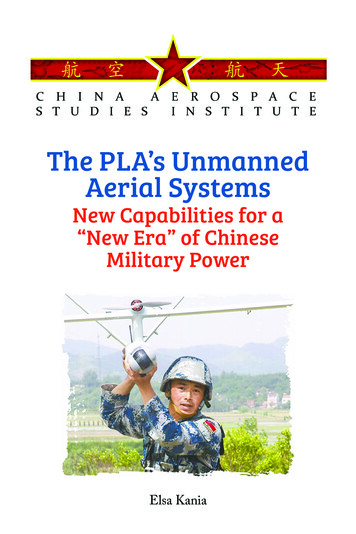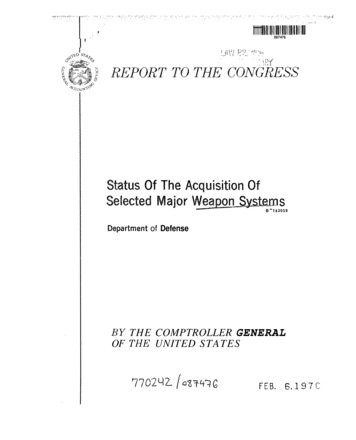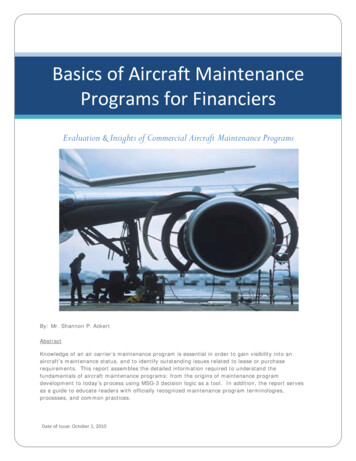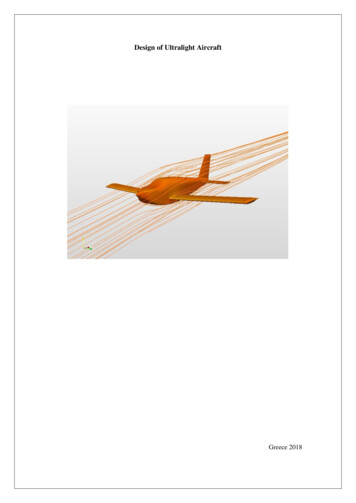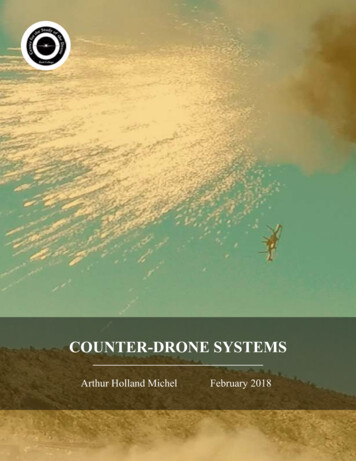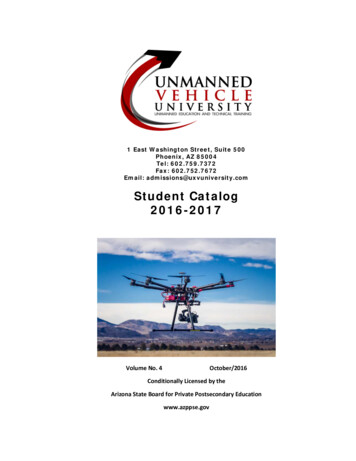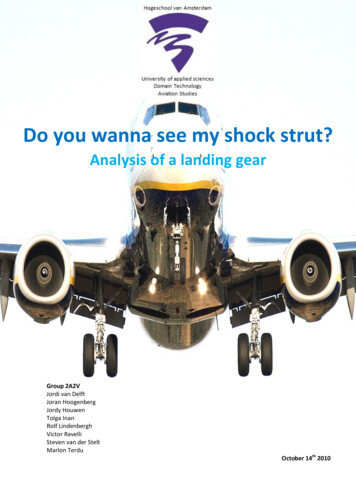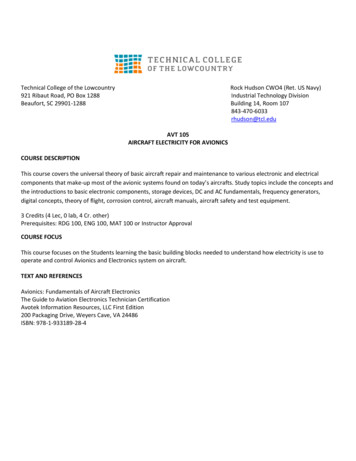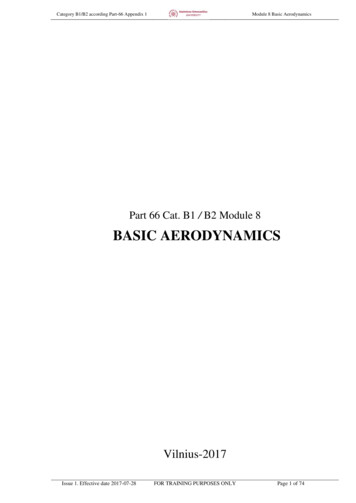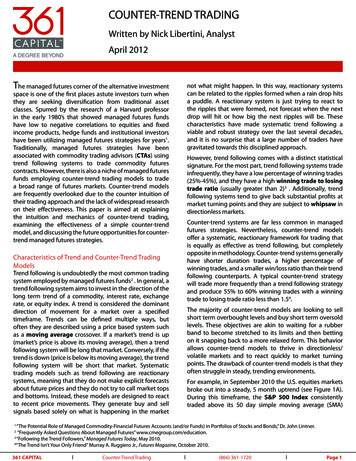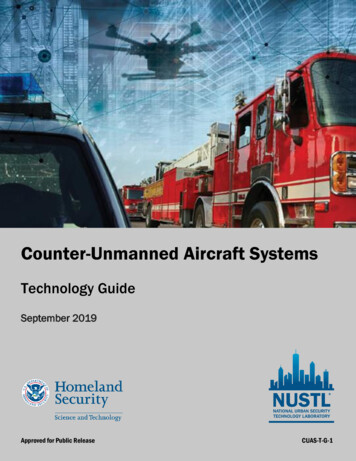
Transcription
Counter-Unmanned Aircraft SystemsTechnology GuideSeptember 2019Approved for Public ReleaseCUAS-T-G-1
The Counter-Unmanned Aircraft Systems Technology Guide was prepared by the U.S. Department of HomelandSecurity, Science and Technology Directorate, National Urban Security Technology Laboratory (NUSTL).Reference herein to any specific commercial products, processes, or services by trade name, trademark,manufacturer, or otherwise does not necessarily constitute or imply its endorsement, recommendation, orfavoring by the U.S. government.The information and statements contained herein shall not be used for the purposes of advertising, nor to implythe endorsement or recommendation of the U.S. government.With respect to documentation contained herein, neither the U.S. government nor any of its employees makeany warranty, express or implied, including but not limited to the warranties of merchantability and fitness for aparticular purpose. Further, neither the U.S. government nor any of its employees assume any legal liability orresponsibility for the accuracy, completeness, or usefulness of any information, apparatus, product, or processdisclosed; nor do they represent that its use would not infringe privately owned rights.- - - Warning - - Federal law prohibits the operation of certain C-UAS technologies described in this Technology Guide. Only theDepartments of Homeland Security, Justice, Defense, and Energy have affirmative authority to take C-UASactions that would normally violate Federal law. This Technology Guide is not intended to opine upon the legalauthorities to operate a C-UAS technology. It is strongly recommended that prior to the testing, acquisition,installation, or use of counter-UAS systems that entities seek the advice of counsel experienced with bothfederal and state criminal, surveillance, and communications laws. Entities should conduct their own legal andtechnical analysis of each UAS detection or mitigation system and should not rely solely on vendors’representations of the systems’ legality or functionality. This is particularly important because potential legalprohibitions are not based on broad classifications of systems (e.g., active versus passive, detection versusmitigation), but instead are based on the functionality of each system. A thorough understanding of bothapplicable law and the systems’ functionality will ensure that important technologies designed to protect publicsafety, by detecting or mitigating UAS threats, are used responsibly and legally.Images included herein were provided by NUSTL, unless otherwise noted.Approved for Public Releasei
FOREWORDThe U.S Department of Homeland Security (DHS) Science and Technology Directorate’s (S&T)National Urban Security Technology Laboratory (NUSTL) provides testing and evaluation services andproducts in order to help first responders and DHS components prepare, protect and respond tohomeland security threats.As a federal government-owned, government-operated laboratory, NUSTL provides independenttechnology evaluations, assessments and technical reports to first responders and DHS components,enabling informed decisions and helping to ensure that responders have the best technologyavailable to use in homeland security missions. As such, NUSTL is positioned as a preferred andtrusted partner with first responder government agencies at the federal, state, local and tribal levels.This Counter-Unmanned Aircraft Systems (C-UAS) Technology Guide is intended to educate thenational first responder community on C-UAS technology. In order to explain how C-UAS technologiesoperate, this guide provides an overview of small unmanned aircraft system technologies, includingkey components enabling their operation. The information provided in this guide includes technical,scientific and engineering expertise offered by NUSTL as well as information gathered from May toJuly 2018 from internet research, industry publications and manufacturer data.The guide is not intended to provide legal advice and makes no comments, evaluation, or assertionsconcerning the legality of any specific purchase or operations of C-UAS technologies by individualfirst responders. Congress has only authorized the Departments of Defense, Energy, Justice, andHomeland Security to engage in limited UAS detection and mitigation activities that would otherwisepotentially violate applicable federal criminal laws, including laws relating to surveillance. No oneelse has been granted that authorization. Accordingly, it is important that other federal, state, local,tribal and territorial (SLTT), and private sector entities without such statutory authority (firstresponders, including SLTT law enforcement, SLTT governments, and owners and operators ofcritical infrastructure, stadiums, outdoor entertainment venues, and airports, among others)understand that federal law may limit, prohibit, or govern the sale, possession, or use of UASdetection and mitigation capabilities.For further assistance, refer to the Department of Justice, Homeland Security, and TransportationLegal Advisory.Approved for Public Releaseii
POINT OF CONTACTNational Urban Security Technology LaboratoryU.S. Department of Homeland SecurityScience and Technology Directorate201 Varick StreetNew York, NY 10014E-mail: NUSTL@hq.dhs.govWebsite: security-technology-laboratoryAuthors:Bhargav Patel, Mechanical Engineer, NUSTLDmitri Rizer, Support Contractor, NUSTLApproved for Public Releaseiii
TABLE OF CONTENTS1.0 Introduction . 62.0 UAS Technology Overview . 72.1 UAV Types and Capabilities. 82.2 UAV Components and Attributes . 92.2.1 Propulsion System . 92.2.2 Flight Controller . 92.2.3 Payloads. 92.2.4 Telemetry Data . 102.3 Ground-Based Control System Components . 102.3.1 Command and Control . 112.3.2 Communication Protocol . 112.3.3 Flight Navigation Modes . 123.0 Counter-UAS Technologies . 133.1 C-UAS Processing Chain . 133.2 Types of C-UAS Sensors . 153.2.1 Radar. 163.2.2 Passive RF . 183.2.3 Electro-Optical/Infrared . 193.2.4 Acoustic. 193.2.5 Comparison of C-UAS Modalities . 203.3 Understanding C-UAS Specifications. 203.3.1 Radar Parameters . 203.3.2 RF Sensor Parameters . 213.3.3 EO/IR Sensor Parameters . 213.3.4 Acoustic Sensor Parameters . 223.4 C-UAS Mitigation Technologies . 223.4.1 Electronic . 233.4.2 Kinetic . 244.0 References . 25Appendix A. C-UAS Questions For DHS Components . A-1Appendix B. Environmental Considerations For Using C-UAS Technologies . B-1Appendix C. Definition of Acronyms . C-1Approved for Public Releaseiv
LIST OF FIGURESFigure 2-1 Small UAS Components and Attributes . 7Figure 2-2 Examples of Small UAS Types . 8Figure 2-3 Examples of Ground-Based Controllers. 10Figure 3-1 C-UAS Processing Chain . 13Figure 3-2 Alternate C-UAS Processing Chains . 15Figure 3-3 Illustration of Radar Distance Measurement. . 16Figure 3-4 Diagram Showing How a Phase Array Antenna Works . 17Figure 3-5 Radar Target Location Coordinates . 17Figure 3-6 Example of 3-D Radar Antennas . 18Figure 3-7 Example of a Passive RF Detection Sensor . 18Figure 3-8 Rotating EO/IR Camera Mounted on a Tripod . 19Figure 3-9 Example of a Microphone Array . 19LIST OF TABLESTable 2-1 UAS Capabilities Examples . 8Table 3-1 C-UAS Processing Chain Stages . 14Table 3-2 Comparison of C-UAS Sensor Modalities . 20Approved for Public Releasev
1.0 INTRODUCTIONThe increasing availability, affordability and capability of commercially available unmannedaircraft systems (UAS), colloquially referred to as drones, provides opportunities for legitimate,nuisance and nefarious uses. Legitimate applications include the use of UAS by public safetyofficials to protect critical infrastructure and gain situational awareness during emergencies, bythe entertainment industry for movies and television and by agricultural and other industries forinspections over large areas. Nuisance incidents include hobbyists operating illegally but withoutmalicious intent. Nefarious applications may include unpermitted surveillance, the distribution ofcontraband or a terrorist attack.Many UAS-related incidents involve the unintentional misuse, or nuisance case, of UAS and posehigher safety risk rather than security risk. However, intentional UAS misuse can cause safetyissues and security concerns. For example, flying a UAS during a wildfire can force responseoperations to cease due to safety concerns, and flying a UAS over a prison wall or the U.S. borderto deliver contraband is a security concern. Terrorist organizations employing UAS are also athreat (Watson, 2017).This technology guide is intended to provide background information to improve theunderstanding of the DHS Components and the national first responder community regardingthe technologies that are designed to counter UAS use. As counter-unmanned aircraft systems(C-UAS) continue to evolve, the need to better understand the components and operationalconsiderations of this technology will also continue to evolve. This guide is designed to providebasic scientific and engineering information on the types of C-UAS modalities that are commonlyemployed in C-UAS systems.This technology guide first includes a brief overview of small UAS and how they operate. SmallUAS, i.e., aircraft weighing less than 55 pounds on takeoff, are sometimes abbreviated as sUAS.sUAS are the only type of UAS addressed in this guide. The abbreviation, UAS, which is usedthroughout this guide, refers specifically to small UAS or sUAS. The UAS overview is included tofacilitate understanding of how various modalities of C-UAS technologies work. C-UAS operationsare based on exploiting one or more UAS processes and physical attributes, such as radio andsound emissions, or material properties and flight characteristics. Also included is informationon specifications or characteristics that are commonly understood for each mode of C-UAStechnology to assist in understanding the technological information that may be used bytechnology manufacturers. Lastly, this guide also includes a list of questions in Appendix Adesigned for DHS components with authority to conduct C-UAS activities build a morecomprehensive understanding of the various modalities employed by specific C-UAS technologysolutions.Reference herein to any specific commercial products, processes, or services by trade name,trademark, manufacturer, or otherwise does not constitute or imply endorsement,recommendation, or favoring by the U.S. government. Discussion of C-UAS technology does notimply that these C-UAS capabilities are legal for first responder purchase or use.Approved for Public Release6
2.0 UAS TECHNOLOGY OVERVIEWDifferent organizations, agencies and manufacturers often use different terms interchangeably,but for the sake of consistency we will use the Federal Aviation Administration (FAA) definitionsthroughout, as found in the glossary (CFR Title 14, Part 107.3): Unmanned aircrafti – an “aircraft operated without the possibility of direct humanintervention from within or on the aircraft.”Small unmanned aircraft – an “aircraft weighing less than 55 pounds on takeoff,including everything that is on board or otherwise attached to the aircraft.”Small unmanned aircraft system – a “small unmanned aircraft and its associatedelements (including communication links and the components that control the smallunmanned aircraft) that are required for the safe and efficient operation of the smallunmanned aircraft in the national airspace system.”It is useful to think of a UAS in terms of its major components: 1) the aircraft, also called anunmanned aircraft vehicle (UAV), and 2) a ground-based control station (GCS), which controls theUAV’s flight. A simplified block diagram is shown in Figure 2-1.UASAircraftGCSTelemetryCommand and ControlFigure 2-1 Small UAS Components and AttributesiNote that both “aircraft” and “aerial” are used to describe unmanned systems.Approved for Public Release7
2.1 UAV TYPES AND CAPABILITIESThere are two primary types of UAVs: fixed wing and rotocopter, as shown in Figure 2-2. SomeUAVs attempt to combine aspects associated with both types; however, these are lessprevalent. Fixed wing UAVs have a motor(s) and propeller(s) to create propulsion in a roughlyhorizontal direction. The flight path is determined by the manipulation of the flight controlsurfaces on the wings (i.e., ailerons) and tail (i.e., rudder and elevator).Rotocopters may have two or more propellers that generate lift in a roughly verticaldirection. Rotocopters have no wings and their flight path is determined by independentlyadjusting the rotation speed of each of their propellers.Fixed WingRotocopterFigure 2-2 Examples of Small UAS TypesThe available capabilities vary greatly between both types of UAV and makes/models of similartypes. Table 2-1 provides examples of capabilities of commercial sUAS, showing approximatedata for a range of specifications (e.g., range, speed, flight time, etc.).Table 2-1 UAS Capabilities ExamplesSpecificationiiValuesRangeSpeedFlight TimePayloadAltitude4 to 60 miles20 to 50 milesper hour (mph)25 to 120 minutes 0 to 15 pounds3,300 to16,000 feetabove meansea levelDJI Mavic Pro: 4 milesYuneec Breeze: 20 mphParrot Bebop 2: 25 minDJI Spark: 1 poundYuneec Q500: 3,300 feetFlightWave Edge: 120 minDJI S1000: 15 poundsDJI Mavic Pro: 16,000 feetExamplesFlightWave Edge: NMS M600: 60 miles 50 mphTable 2-1 provides examples of sUAS capabilities as of July 2018, based on information gathered from a sample ofmanufacturer websites. Note that the FAA sets operational limitations for UAS flight operations under the Small UASRules (Part 107) for specifications such as speed and altitude (FAA sUAS Part 107: The Small UAS Rules).iiApproved for Public Release8
2.2 UAV COMPONENTS AND ATTRIBUTESUAVs can be further deconstructed into many sub-systems and attributes. For the purposes ofunderstanding the capabilities of C-UAS technologies, we will limit this section to just thepropulsion system, flight controller, payloads and telemetry data.2.2.1 PROPULSION SYSTEMMost small UAVs are propeller driven and powered by one or multiple electric motors. Theenergy is provided by an on-board rechargeable battery. Small UAVs may also be powered byinternal combustion engines, or hybrid gas-electric systems where a generator keeps abattery charged but propulsion is provided by electric motors.2.2.2 FLIGHT CONTROLLERThe flight controller is a small on-board computer that acts as the central hub for directingall inputs and outputs to and from the UAV. Often times the flight controller will includeseveral built-in sensors such as gyroscopes, accelerometers and Global Positioning System(GPS) receivers. The flight controller will direct all operations in the UAV, this includes: Managing the amount of power drawn from the battery and power distribution to thevarious components of the UAVConnecting radio frequency (RF) receivers and transmitters (i.e., GPS receivers,command and control (C2) receivers and telemetry transmitters)Connecting and operating sensors (i.e., thermal sensors, proximity sensors, etc.) andpayloads (i.e., actuators, cameras, etc.)Connecting and operating the flight control surfaces (i.e., wings, propellers, etc.) ofthe UAV.2.2.3 PAYLOADSSmall UAVs can carry payloads which are additional packages added to the UAV. Payloadsmay be innocuous, or may be malicious, including: CamerasSensorsAerosol dispersersMedical suppliesExplosives, chemical, biological or radiological substances, or other weaponsHazardous materialsRadiofrequency transmitters or receiversSurveillance equipmentOther cargo.Some payloads can be manipulated remotely, for example, the movement and zooming of acamera lens. Many UAS come standard with one or more built-in cameras.Approved for Public Release9
2.2.4 TELEMETRY DATATelemetry is the term used to describe information that is transmitted from the UAV to theGCS. This may include: Video and audio dataBattery statusAltitudeSpeedDirection of flightAir temperatureLaunch locationOthers.Telemetry information is generally derived from on-board sensors such as: Inertial measurement unitAccelerometerGyroscopesTemperature sensorsCamerasInfrared sensorsRF receiversSonar sensors.2.3 GROUND-BASED CONTROL SYSTEM COMPONENTSA GCS, or controller, can be a hand controller, laptop, visual display or some combination ofthese items that transmits commands to a UAV and receives telemetry data from the UAV. Thecontroller facilitates the human interface with the UAS.Using a controller, a remote operator can control motor power, flight control surfaces, an onboard camera and other sensors wirelessly. Telemetry, UAV status warnings and notificationscan be presented to the remote pilot using a built-in or attached display. Examples of GCS areshown in Figure 2-3.As shown in Figure 2-3, there are two primary attributes that are associated with the GCS:communication protocols and C2.Figure 2-3 Examples of Ground-Based ControllersApproved for Public Release10
2.3.1 COMMAND AND CONTROLCommand and control (commonly called C2) is the term used to describe the set ofcommands transmitted from the GCS to the UAV, which leads to changes in the operation ofthe UAV, such as: speed, direction of flight and altitude. C2 transmissions may also be usedto manipulate other payloads and sensors on the UAV (e.g., pan, tilt, zoom andrecord/capture of an on-board camera) or to transition between different types of flightnavigation modes.2.3.2 COMMUNICATION PROTOCOLA communication protocol is a system of rules that allows two or more end nodes of anetwork to exchange information. Communication protocols define the rules, syntax,semantics and synchronization of communication data between two or more nodes. It mayalso include information about how data should be compressed, encrypted or recoveredfrom data error issues.For UAS, a protocol defines how the control, telemetry and video data are to be encoded,transmitted and decoded to facilitate communication between the GCS and UAV.Communication between the GCS and UAV may use standard, or proprietary, protocols.Examples of UAS-specific protocols include but are not limited to: LightbridgeOcusyncMAVlink.Communication protocols use special formatting methods to determine message structure.Most protocol messages contain three main parts: Header: The portion of a data frame that precedes the message data. It usuallycontains information such as who the sender and receiver are, protocols governingthe format of the message and any synchronization information allowing the receiverto adapt the way it should process signals. Message Data: Sometimes called the ‘payload,’ it is the actual message or fragmentof a longer message to be transmitted. For example, it can be a command sent fromthe GCS to the UAV, or a video frame from on-board UAV camera back to the GCS. Footer: A portion of the data packet that may contain control and information fields.The footer is often used to verify error-free reception of the information by thereceiving device.Communication protocols are transmitted via a medium. For UAS the medium is the radiospectrum: wireless RF emissions between 3 kHz and 300 GHz in the United States (Office ofSpectrum Management, National Telecommunications and information Administration, U.S.Department of Commerce, 2003).Most consumer UAVs and their GCS use the same radio bands as Wi-Fi compatible devices(2.4 GHz and 5.8 GHz) to both control the UAV and transmit telemetry information from theUAV to the operator. More advanced and hobbyist platforms can be fitted with modems thattransmit and receive data at 433 MHz or 915 MHz.Approved for Public Release11
Three of the four radio bands mentioned: 2.4 GHz, 5.8 GHz, and 915 MHz, are part of theindustrial, scientific and medical (ISM) radio bands, defined by the Federal CommunicationsCommission (FCC), which do not require licenses for use to transmit (FederalCommunications Commission, 2010). The 433 MHz band is considered to be a regulatedband in the United States and is generally reserved for amateur radio operators. Accordingto international standards it is also considered to be part of the ISM radio bands (FederalCommunications Commission, 2018). These are the most common transmission bands forcommercially available UAS, but any other portion of the radio spectrum could theoreticallybe used in a custom system.2.3.3 FLIGHT NAVIGATION MODESThe three common flight navigation modes that are used to remotely operate a UAV are: Manual Navigation: Under the manual navigation mode, the UAV is directly controlledin real time by a remote, human pilot who manipulates joysticks, buttons and/orknobs on a controller. Manual navigation relies on uninterrupted and continuousradio communication between the UAV and controller. Manual navigation cansometimes include first person viewing (FPV), in which a pilot operates the UAV byrelying on a live video feed from the UAV in a display mounted on the remotecontroller or in headset. GPS Navigation: Many UAVs are equipped with GPS receivers that tell them wherethey are in space and time. Relying on the GPS system, UAVs can be pre-programmedto fly autonomously to specified locations (also known as waypoints) or use specifiedflight paths. This navigation mode can be achieved without any radio emissions fromthe UAV or GCS, although many UAVs may emit a “heartbeat” signal that occasionallytransmits telemetry, for safety reasons, back to the controller. This heartbeatfunction is a safety feature that can be turned off to avoid radio emissions. Autonomous Navigation: Some UAVs have the capability of navigating using only theirown on-board sensors, as opposed to relying on received signals from the GPSsystem. These sensors can include, but are not limited to: accelerometers,gyroscopes, magnetometers, video cameras and collision avoidance sensors. In thismode, the UAV can follow moving objects or people, fly towards a stationary object ata distance or navigate by dead reckoning. UAVs relying on autonomous navigationmay not emit any radio signals and may be entirely unaffected by any impediments inradio signal propagation or interference.Approved for Public Release12
3.0 COUNTER-UAS TECHNOLOGIESVarious technologies exist to counter use of UAS. These technologies, collectively referred to asC-UAS technologies, employ a variety of sensors and processes that account for or exploit thephysical components of a UAS and the communications between the UAV and the GCS.Federal law prohibits the operation of certain C-UAS technologies described in this section of thisguide.iii Only the Departments of Homeland Security, Justice, Defense, and Energy have receiveda legislative exception to those Federal laws to conduct C-UAS. This portion of the TechnologyGuide is intended to provide background information about C-UAS technology, and is notintended to imply that any agencies other than those listed above have the lawful authority topurchase, possess or use such systems. Please consult with an attorney experienced with bothfederal and state criminal, surveillance, and communications laws. Entities should conduct theirown legal and technical analysis of each UAS detection or mitigation system and should not relysolely on vendors’ representations of the systems’ legality or functionality. This is particularlyimportant because potential legal prohibitions are not based on broad classifications of systems(e.g., active versus passive, detection versus mitigation), but instead are based on thefunctionality of each system. A thorough understanding of both applicable law and the systems’functionality will ensure that important technologies designed to protect public safety, bydetecting or mitigating UAS threats, are used responsibly and legally.3.1 C-UAS PROCESSING CHAINA C-UAS processing chain (Figure 3-1) is a framework for approaching the potential threatposed by UAS that can be used by technology developers and public safety officials alike.Terms and definitions within this processing chain may be different depending on theaudience (e.g., developers, operators and government agencies), and not all C-UAStechnologies are able to address all of the activities identified by this processing chain, or inthe same Figure 3-1 C-UAS PThis processing chain and description can be used as a reference to understand how differentC-UAS technologies operate. Table 3-1 defines the terms identified in the C-UAS processingchain.See generally, Pen/Trap Statute, 18 U.S.C. §§ 3121-3127, Wiretap Act, 18 U.S.C. § 2510; Aircraft Sabotage Act,18 U.S.C. § 32(a); Computer Fraud and Abuse Act, 18 U.S.C. § 1030; 18 U.S.C. § 1362; 18 U.S.C. § 1367; 47 U.S.C.§ 301; 47 U.S.C. § 302a; and 47 U.S.C. § 333.iiiApproved for Public Release13
Table 3-1 C-UAS Processing Chain StagesDetectA detection is a declaration that a UAS is in the presence of a sensor. Somesystems, depending on how thresholds are configured, may report any objectin its view as a detection (i.e., birds, commercial planes, etc.), or they mayattempt t
Counter-Unmanned Aircraft Systems Technology Guide was prepared by the U.S. Department of Homeland Security, Science and Technology Directorate, National Urban Security Technology Laboratory (NUSTL). Reference herein to any specific commercial p
